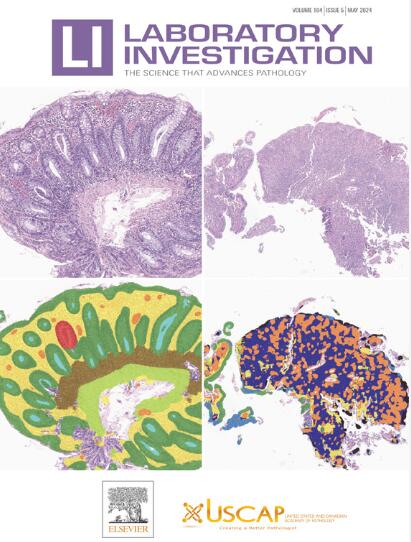解码262个子宫肉瘤的分子景观:ESS, UTROSCT和UUS的RNA-Seq聚类与预后见解。
IF 4.2
2区 医学
Q1 MEDICINE, RESEARCH & EXPERIMENTAL
引用次数: 0
摘要
低级别子宫内膜间质肉瘤(LG-ESS)、高级别子宫内膜间质肉瘤(HG-ESS)、未分化子宫肉瘤(UUS)和类似卵巢性索肿瘤的子宫肿瘤(UTROSCT)是不同的非平滑肌细胞肿瘤,临床结果不同,通常表现出重叠特征。诊断可以通过识别特征性的复发性易位来支持,在某些情况下可能不存在易位,使模棱两可病例的区分复杂化。此外,还可以识别出LG和HG特征重叠的病例。为了解决这些挑战,我们分析了262例病例的RNA-Seq谱。我们的研究结果显示,有或没有复发性融合的LG-ESS聚集成两个部分重叠的表达谱,与不同的总体和无复发生存结果相关,其中包含大多数融合阴性肿瘤的集群表现出更好的预后。UTROSCT表达谱与两个LG-ESS亚组非常相似,NCOA3融合阳性病例聚集在生存结果较好的组中。此外,鉴定出具有bor和YWHAE融合的HG-ESS的独特集群,将这些肿瘤与没有融合的HG-ESS区分开来。ONECUT3作为这种hg - ess融合实体的潜在特异性标记物出现。在未融合的单态HG-ESS和多形性UUS之间观察到显著的表达重叠。这些样本进一步分成两个混合簇,以免疫活性差异区分,这显著影响总体生存和无复发生存结果。UUS的无监督聚类揭示了类似于HG-ESS或肌肉细胞分化肿瘤的亚群,表明UUS可能包括低分化的不同实体,如平滑肌肉瘤,并且在某些情况下与HG-ESS的区分可能是任意的。我们的转录组分析突出了几个具有不同生存特征的实体,为进一步表征这些罕见的、通常难以分类的肿瘤提供了基础。本文章由计算机程序翻译,如有差异,请以英文原文为准。
Decoding the Molecular Landscape of 262 Uterine Sarcomas: RNA-Seq Clustering of Endometrial Stromal Sarcomas, Uterine Tumors Resembling Ovarian Sex Cord Tumors, and Undifferentiated Uterine Sarcomas With Prognostic Insights
Low-grade endometrial stromal sarcomas (LG-ESS), high-grade ESS (HG-ESS), undifferentiated uterine sarcomas (UUS), and uterine tumors resembling ovarian sex cord tumors are distinct non-smooth muscle cell neoplasms with varying clinical outcomes, often exhibiting overlapping characteristics. Diagnosis can be supported by identifying characteristic recurrent translocations, which may be absent in some cases, complicating the distinction of equivocal cases. Additionally, cases with overlapping features of low-grade and high-grade characteristics are recognized. To address these challenges, we analyzed RNA-seq profiles of 262 cases. Our results revealed that LG-ESS, with and without recurrent fusions, clustered into 2 partially overlapping expression profiles associated with distinct overall and relapse-free survival outcomes, with the cluster containing a majority of fusion-negative tumors demonstrating better prognoses. uterine tumors resembling ovarian sex cord tumors expression profiles closely resembled those of both LG-ESS subgroups, with NCOA3 fusion-positive cases clustering in groups with better survival outcomes. Furthermore, a distinct cluster for HG-ESS with BCOR and YWHAE fusions was identified, differentiating these tumors from HG-ESS without fusions. ONECUT3 emerged as a potential specific marker for this HG-ESS-fusion entity. A significant expression overlap was observed between monomorphic HG-ESS without fusions and pleomorphic UUS. These samples separated further into 2 mixed clusters distinguished by differences in immune activity, which significantly influenced overall survival and relapse-free survival outcomes. Unsupervised clustering of UUS revealed subgroups resembling either HG-ESS or muscle-cell–differentiated tumors, suggesting that UUS may include poorly differentiated distinct entities, such as leiomyosarcoma, and that the distinction from HG-ESS may, in some cases, be arbitrary. Our transcriptome analysis highlights several entities with distinct survival characteristics, providing a foundation for further characterization of these rare, often difficult-to-classify, tumors.
求助全文
通过发布文献求助,成功后即可免费获取论文全文。
去求助
来源期刊

Laboratory Investigation
医学-病理学
CiteScore
8.30
自引率
0.00%
发文量
125
审稿时长
2 months
期刊介绍:
Laboratory Investigation is an international journal owned by the United States and Canadian Academy of Pathology. Laboratory Investigation offers prompt publication of high-quality original research in all biomedical disciplines relating to the understanding of human disease and the application of new methods to the diagnosis of disease. Both human and experimental studies are welcome.
 求助内容:
求助内容: 应助结果提醒方式:
应助结果提醒方式:


